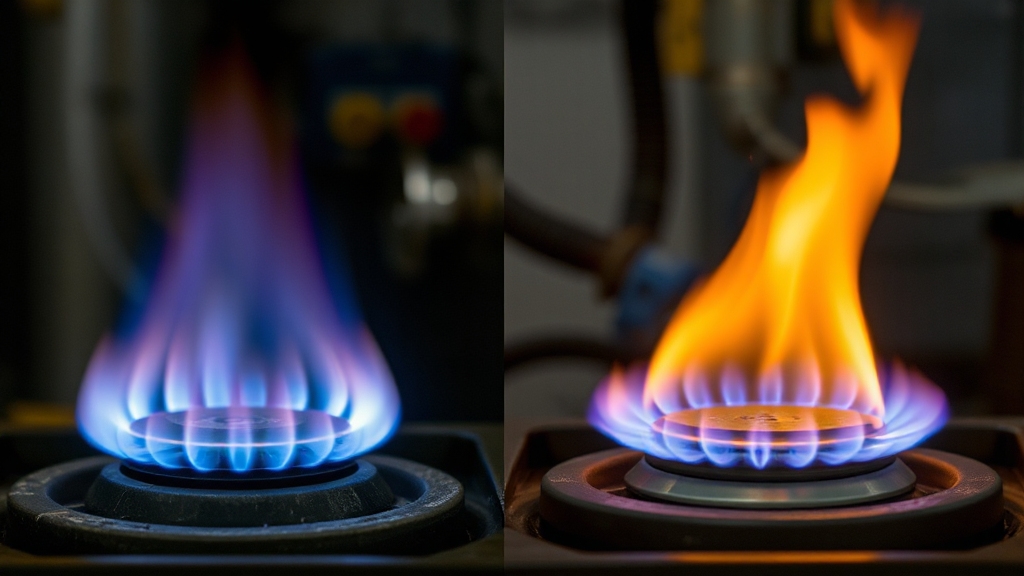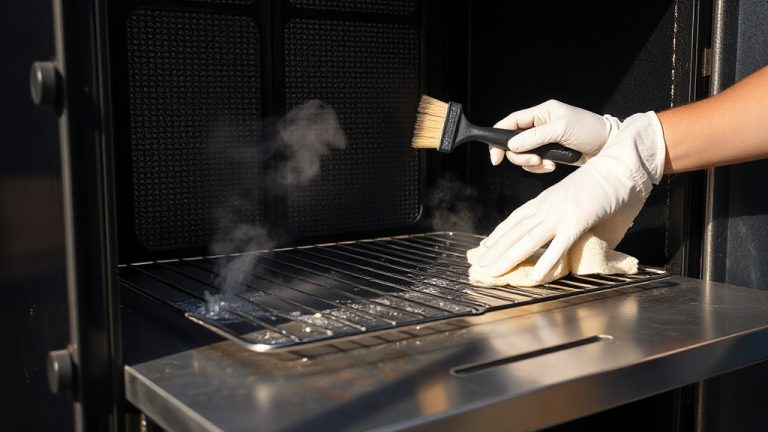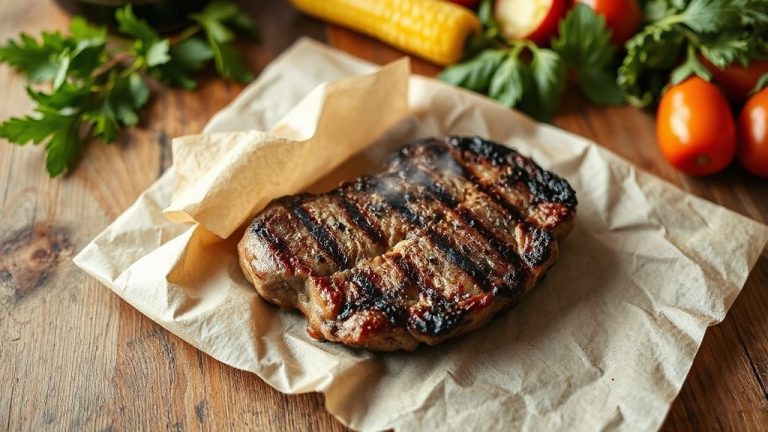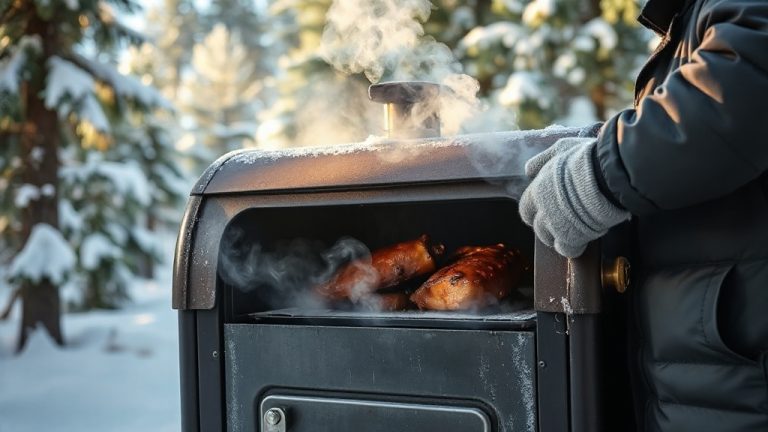Does Propane Burn Hotter Than Natural Gas? See the Facts
You’ll find propane burns hotter than natural gas, with flame temperatures around 1,980°C in air compared to natural gas’s 1,770°C to 1,980°C range.
Propane delivers over twice the heat per volume, enabling more efficient and intense combustion. Its higher energy density means smaller burner orifices and easier ignition.
Understanding these differences helps optimize fuel choice for your specific heating needs and application environments—you’re about to uncover more detailed insights on performance and practical use.
Key Takeaways
- Propane flames reach about 1,980°C in air, slightly hotter than natural gas flames, which range from 1,770°C to 1,980°C.
- In pure oxygen, propane burns hotter at approximately 2,820°C compared to natural gas’s 2,770°C flame temperature.
- Propane’s higher energy density (2,520 BTUs/ft³) results in more intense heat output per unit volume than natural gas.
- Propane requires smaller burner orifices due to its higher heat output and burns more efficiently than natural gas.
- Propane’s lower ignition energy and combustible limits contribute to easier ignition and higher flame stability than natural gas.
Heat Output Comparison Between Propane and Natural Gas
Although both propane and natural gas serve as common heating fuels, propane delivers more than twice the heat energy per cubic foot compared to natural gas, producing approximately 2,516 to 2,520 BTUs versus natural gas’s 1,012 to 1,030 BTUs.
You’ll find propane’s higher BTU per volume means it provides more efficient heat output per unit of fuel consumed. Propane’s energy density allows smaller storage tanks and less frequent refilling compared to natural gas, which is typically measured in therms or cubic feet.
While one gallon of propane yields about 91,452 BTUs, natural gas’s equivalent volume produces less heat. This distinction translates directly into reduced fuel consumption for equivalent heat output when using propane, enhancing system efficiency and operational practicality in heating applications.
Additionally, propane is stored on-site, ensuring continuous access to fuel regardless of utility outages.
Flame Temperature Differences in Various Conditions
When you compare propane and natural gas flames, their temperatures vary markedly depending on the combustion environment. In air, propane flames reach about 1,980°C, slightly hotter than natural gas flames, which range from 1,770°C to 1,980°C.
Both gases achieve notably higher temperatures in pure oxygen—propane around 2,820°C and natural gas near 2,770°C—due to increased combustion efficiency and oxygen availability. These values represent theoretical maximums assuming no heat loss.
Burner design and air-fuel mixing critically influence practical flame temperatures; propane’s higher energy density and heavier molecular weight require smaller orifices and richer mixtures, producing shorter, hotter flames.
Environmental factors like altitude, humidity, and airflow affect flame stability and temperature by altering oxygen concentration and heat loss.
Ignition Characteristics and Safety Implications
You’ll notice propane ignites at a lower temperature than natural gas, which influences how you manage ignition timing and burner design. Natural gas requires specific ignition energy and carefully calibrated burner systems to guarantee stable combustion.
Propane Ignition Temperature
Because propane ignites within a relatively narrow temperature range—typically between 920°F and 1020°F—you need to carefully control environmental conditions to prevent accidental ignition.
Its autoignition temperature can vary from 878°F to 1020°F depending on pressure and air mixture. This sensitivity demands strict safety measures when handling propane.
Key considerations include:
- Maintaining temperatures well below propane’s ignition threshold to avoid spontaneous combustion.
- Monitoring propane concentration, which must remain outside the flammability limits of 2.15% to 9.60% in air.
- Ensuring proper ventilation to prevent accumulation of gas within explosive limits.
- Utilizing odorants like ethyl mercaptan to detect leaks before ignition risks arise.
The vapor pressure of propane rises significantly with temperature, reaching up to 23.5 PSIG at 100°F, which influences storage and handling safety.
Natural Gas Ignition Needs
Propane’s ignition characteristics highlight the importance of managing temperature and concentration to prevent hazards. When working with natural gas, you must maintain the air/fuel ratio between 4% and 14% for ignition.
Outside this explosive range, the mixture is either too lean or too rich to ignite. Natural gas requires a relatively high ignition temperature of about 1,150°F to 1,200°F, making it less sensitive to accidental ignition than other fuels.
You’ll benefit from understanding these parameters to optimize combustion efficiency and safety. Additionally, natural gas is odorless, so an odorant is added to help detect leaks at concentrations below 1%.
| Parameter | Value |
|---|---|
| Ignition Temperature | 1,150°F – 1,200°F |
| Explosive Range | 4% – 14% natural gas in air |
| Specific Gravity | ~0.6 (lighter than air) |
Safety and Burner Design
Although both propane and natural gas serve as common fuels, their distinct ignition characteristics demand careful consideration in burner design and safety protocols.
Propane ignites more easily due to lower ignition energy, requiring smaller burner orifices and precise combustion chamber adjustments. Additionally, propane’s combustible limits range from 5-15% in air, which influences flame stability and safety margins.
Natural gas, with better lean burn capability, benefits from advanced ignition systems like Turbulent Jet Ignition that enhance stability and reduce emissions.
Safety implications include managing higher propane flame temperatures and energy density, necessitating robust pressure control and specialized detectors.
Key considerations include:
- Adjust burner orifice size for fuel-specific energy density.
- Ensure proper ventilation to prevent fuel accumulation.
- Implement tailored leak detection systems.
- Comply strictly with regulatory safety standards.
Fuel Properties Affecting Burner Design and Usage
When selecting or designing burners, you must consider the distinct fuel properties that influence combustion characteristics and safety requirements. Propane’s higher energy density (2,520 BTUs/ft³) demands smaller orifices and affects burner ratings for efficiency.
Its lower ignition temperature simplifies igniter design but requires stringent ventilation due to its heavier-than-air nature. Natural gas, with a higher ignition temperature (~1,150°F) and lower energy density (1,012 BTUs/ft³), calls for more robust igniters and larger orifices, benefiting from its lighter-than-air properties.
Additionally, propane provides more than twice the Btus of natural gas for the same volume, making it a more energy-dense fuel option.
| Property | Propane | Natural Gas |
|---|---|---|
| Ignition Temp (°F) | 920–1,120 | ~1,150 |
| Specific Gravity | 1.52 (heavier than air) | 0.6 (lighter than air) |
| Energy Density (BTU/ft³) | 2,520 | 1,012 |
| Flame Temp (°F) | ~3,560 | ~3,560 |
Practical Applications for Propane and Natural Gas
Below are some of the most common and efficient ways these fuels are used across residential, commercial, and industrial settings.
Outdoor Heating Preferences
Since outdoor heating demands vary by space and usage, choosing between propane and natural gas hinges on factors like heat output, installation complexity, and portability.
You’ll find propane burns hotter, making it ideal for larger open areas, while natural gas suits fixed installations with existing gas lines.
Consider these points:
- Heat Output: Propane delivers higher BTUs, providing more effective warmth outdoors.
- Installation: Natural gas requires professional setup and a gas line; propane uses portable tanks. Natural gas heaters typically offer cost-effective operation once installed.
- Portability: Propane systems allow flexible placement and easy relocation.
- Cost and Maintenance: Natural gas often costs less per unit but has higher installation expenses; propane may save long-term where gas lines are unavailable.
Analyze your space and usage to select the fuel that aligns with your outdoor heating needs efficiently and safely.
Residential Heating Choices
Although both propane and natural gas serve as effective residential heating fuels, their practical applications differ based on efficiency, cost, infrastructure, and environmental factors.
You’ll find propane offers higher heat output—2,516 BTUs per cubic foot versus natural gas’s 1,030—leading to greater fuel efficiency and reduced consumption. Propane furnaces burn less fuel, require less maintenance, and can offset higher upfront costs due to efficiency.
However, natural gas usually costs less per unit and benefits from extensive pipeline infrastructure, making it ideal for connected homes. Natural gas is typically delivered via pipeline, providing a continuous and convenient fuel supply.
Environmentally, propane emits fewer overall pollutants, despite natural gas producing less CO2 but more methane.
You’ll prefer propane if your home lacks natural gas access or you need fuel portability. Both fuels support residential heating, water heating, and appliance use, but your choice hinges on local availability and infrastructure.
Remote Location Fueling
When choosing fuel for remote locations, you must consider factors like energy density, delivery logistics, and infrastructure availability. Propane often outperforms natural gas in these areas due to its higher BTU output per cubic foot and portability. Here’s what you need to know:
- Energy Density: Propane delivers 2,520 BTUs per cubic foot versus natural gas’s 1,012, providing more heat per volume.
- Delivery Logistics: Propane tanks allow flexible truck delivery, unlike natural gas, which depends on pipelines.
- Infrastructure: Remote sites rarely have natural gas pipelines, making propane storage tanks a practical alternative. Additionally, propane’s consistent availability through on-site storage ensures reliable fuel access even during utility outages.
- Emergency Use: Propane’s portability and higher energy output make it preferable in emergencies.
Choosing propane simplifies fueling in remote environments, despite higher costs and storage requirements, due to its logistical advantages and energy efficiency.
Efficiency and Cost Considerations of Both Fuels
Because propane delivers more than twice the energy per cubic foot compared to natural gas, you’ll find it more efficient in heating applications where fuel volume matters.
A propane furnace consumes markedly less fuel volume to achieve the same heat output, enabling faster and more intense heating. Additionally, propane’s portability through storage in tanks or cylinders makes it an excellent choice for rural or remote locations where natural gas pipelines are unavailable.
However, propane’s higher efficiency comes with increased per-unit fuel costs compared to natural gas, especially in regions with established pipeline infrastructure that lowers natural gas distribution expenses. Installation costs also differ, with natural gas line setups often exceeding the expense of adding a propane tank.
Frequently Asked Questions
Can Propane and Natural Gas Be Mixed Safely in the Same Appliance?
You shouldn’t mix propane and natural gas in the same appliance because their energy densities and combustion characteristics differ markedly. This mismatch can cause inconsistent combustion, risking appliance damage and safety hazards.
Appliances are designed and calibrated for one specific gas type, so blending these fuels violates safety codes and voids warranties.
To guarantee safe operation, use only the prescribed fuel or professionally convert appliances following regulatory guidelines and manufacturer instructions.
How Do Propane and Natural Gas Emissions Compare Environmentally?
You’ll find propane emits slightly more CO2 per unit of heat than natural gas, but it’s more energy-efficient and classified as a clean fuel under the Clean Air Act.
Natural gas, mainly methane, leaks can considerably worsen its environmental impact due to methane’s high warming potential. Propane’s emissions degrade quickly in the atmosphere, making it a lower-emission choice than coal or gasoline, especially when renewable propane is used.
What Maintenance Differences Exist Between Propane and Natural Gas Systems?
You’ll find propane systems need regular tank inspections, fuel line leak checks, and regulator monitoring. Natural gas systems require frequent piping inspections and valve maintenance.
Propane typically demands less frequent appliance servicing and lower maintenance costs due to simpler components. Natural gas systems, however, call for meter calibration and more urgent leak repairs because of pipeline delivery risks.
Are There Differences in Storage Requirements for Propane Versus Natural Gas?
You’ll find propane requires pressurized tanks stored outside, away from heat, with regular inspections to prevent leaks, as it’s denser than air and can accumulate in low areas.
Natural gas, however, is delivered via underground pipelines and is lighter than air, dispersing quickly but making leak detection tougher. Its storage demands extensive infrastructure, unlike propane’s tank-based system.
How Does Altitude Affect Propane and Natural Gas Combustion Efficiency?
Altitude thins the air’s lifeblood, challenging combustion’s delicate dance. You’ll find both propane and natural gas struggle as oxygen wanes, reducing heat output and flame stability.
Propane, however, holds its ground better, maintaining more efficient combustion and reliable relight in thin air. To keep your appliances safe and efficient, you must adjust fuel-air mixtures and burner settings, and make certain flue passages are properly sized for high-altitude conditions.
Choose the Right Fuel Between Propane vs Natural Gas Wisely
When choosing between propane and natural gas, think of them as different engines built for specific tasks. Propane burns hotter, offering higher flame temperatures and greater heat output, which suits applications demanding intense, focused heat.
Natural gas, while cooler, provides efficiency and cost benefits for broader, steady use. Understanding these distinctions helps you optimize burner design, safety, and fuel efficiency, ensuring your system runs precisely as intended without compromise.






